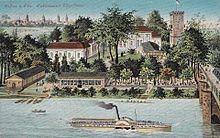Elbe Customs House

The Elbzollhaus is a historic building complex on the Elbe bridge between Dessau and Roßlau . Prince Franz (1740–1817) had the customs house built in 1789 based on a design by the German architect Friedrich Wilhelm von Erdmannsdorff (1736–1800).
History of origin
After Prince Franz had a new bridge built over the Elbe in 1787, only two years later, in 1789, he commissioned the aristocratic architect Friedrich Wilhelm Freiherr von Erdmannsdorff to build a customs house on the Elbe. Erdmannsdorff is one of the most important representatives of early German classicism . As early as 1758 he entered the service of Prince Franz von Anhalt-Dessau, as the latter wanted to convert his lands into a coherent garden kingdom. The new court architect should not only beautify the landscape, but also upgrade it with country houses of different architectural styles, temple architecture based on antiquity, bridges and monuments. According to the wishes of his employer, the castle in Wörlitzer Park was built under Erdmannsdorff's leadership . Further buildings in Wörlitz and the surrounding area followed. Among other things, he designed the Rote Wallwachhaus , the Friederikenbrücke, the Wörlitz town hall , the palace theater , the Branconi Palace and the Luisium Palace .
History of the building
The Prince's customs officers stopped passing ships at this point in order to collect the toll. There were 47 customs posts along the Elbe at the beginning of the 17th century. Roßlau was one of four customs offices in Anhalt. Since the Elbzollhaus is also located on an Elbe bridge, ferry and bridge fees were also required there from those who wanted to go to the other bank.
From 1806 to 1814 ( French times) the Elbe was as good as closed due to the continental barrier. After that there was some relief; the customs house gradually lost its function.
In 1877 the Berlin-Anhaltische Eisenbahn-Gesellschaft bought the house and the property to build the Roßlau railway bridge .
A bridge builder bought it nine years later. In 1919 the property was foreclosed and sold to the innkeeper Karl Henning.
In 1927 it was acquired by the Central German Regatta Association; he was expropriated in 1945 on the orders of the Soviet military administration in Germany ( SMAD ). The property was given to the city of Dessau, which leased it to the city of Roßlau. The house was used by the Roßlauers as a station for young naturalists and technicians until the fall of the Berlin Wall . The house has been empty since 1990.
In 2000, a group of investors announced that they would revive the building with an Elbterrassen restaurant and a craft business. There was no opening.
Todays use
Construction has been going on since 2008 and a new concept has been developed. The new owners completed the restoration work on the historic buildings in May 2012 and implemented their plans to convert the premises into a guesthouse with a café, daily public breakfast and caravan parking space . Today the Elbzollhaus is one of the most famous event locations in Dessau-Roßlau. Up to 70 guests can celebrate in the large hall of the main building, and 2 large outdoor terraces allow events for up to 200 people. In addition to anniversaries and conferences, weddings and small open air events are also held here.
Location and surroundings
The Elbzollhaus Dessau-Roßlau is located in the middle of the Garden Realm , directly on the Lutherweg Saxony-Anhalt and in close proximity to the Elbe Cycle Path , Mulder Cycle Path and Prince Franz Weg. From here are u. a. also the Garden Kingdom in Wörlitz, the historic city of Lutherstadt Wittenberg , Ferropolis "City of Iron", the Masters' Houses and the Bauhaus or the Goitzsche recreation area are easily accessible.
Today's views
View of the Elbe Bridge
literature
- Hans-Joachim Kadatz: Friedrich Wilhelm von Erdmannsdorff: pioneer of German early classicism in Anhalt-Dessau. Publishing house for construction, 1986
- Norbert Eisold, Edeltraud Lautsch: Saxony-Anhalt: Between Harz and Fläming, Elbe, Unstrut and Saale - a cultural landscape rich in monuments. Anhaltische Verlagsgesellschaft, 1991
- Roland Krawulsky: Guide to Dessau-Wörlitz: Palaces and Gardens. DuMont Reiseverlag, 1997, ISBN 3770139682
- Erhard Hirsch: Dessau-Wörlitz: Enlightenment and Early Classics. "Adornment and epitome of the 18th century." Stekovics, 2006
- Norbert Michels: Anhalt in old views: landscape, architecture, living worlds. Mitteldeutscher Verlag, 2006, ISBN 3898123502
- Hansjörg Küster, Ansgar Hoppe: The Garden Kingdom of Dessau-Wörlitz: Landscape and History. CH Beck, 2010, ISBN 3406598595
Web links
- Website of the Elbzollhaus Dessau-Roßlau
- Thomas Steinberg: Tower of the Elbzollhaus offers a unique view. In: Mitteldeutsche Zeitung . April 29, 2010, accessed January 9, 2014 .
- Heidi Thiemann: Sleeping Beauty is ended. In: Mitteldeutsche Zeitung. April 7, 2010, accessed January 9, 2014 .
Individual evidence
- ↑ More details in Meyer's Großes Konversations-Lexikon, Volume 5. Leipzig 1906, pp. 593–594 (online here )
Coordinates: 51 ° 52 ′ 45.1 ″ N , 12 ° 14 ′ 15.8 ″ E




